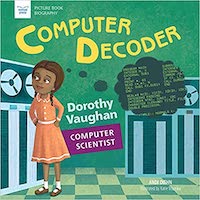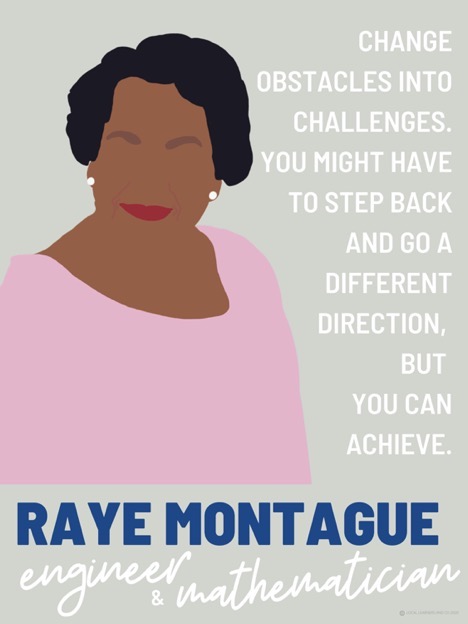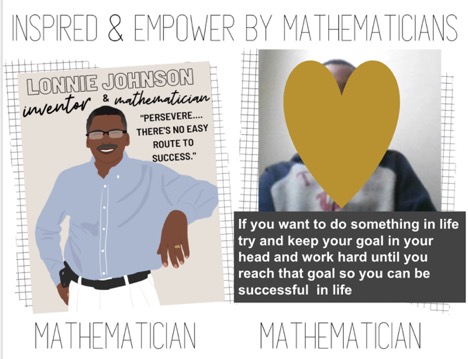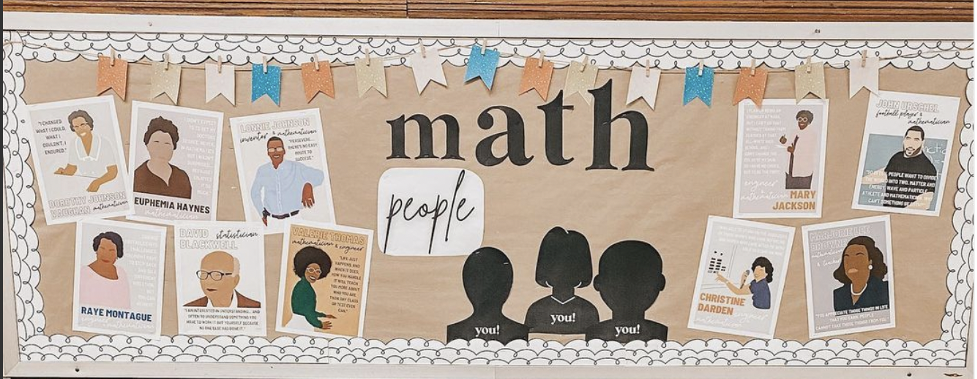Black History Figures Inspire Math Classes
 By Mona Iehl
By Mona Iehl
As a teacher I strive to teach children first and then curriculum.
In order to live out this mission I make it a priority to create a classroom community that feels safe for students to truly belong. I intentionally plan for how I will help my students be “seen” in our classroom.
A big part of feeling safe to be yourself is to feel like you can show up as your true self. I want all my students to be able to see themselves in math, to be represented in our work together, and to understand they are fully capable of mastering mathematics.
As part of this broad mission, I recently used the stories of Black mathematicians to empower and inspire. As you will learn if you read on, my students hear similar stories about immigrant and LGBTQ+ mathematicians – and many others.
What is a Mathematician?
If you asked your students to name a mathematician, could they? Have you asked your students what they think a mathematician looks like? Or maybe just to name as many mathematicians as they can? In my experience students often don’t have a clear definition for what a mathematician is and can rarely name one.
I want my students to know about mathematicians, so they can see themselves as mathematicians in the real world. It is important that students find role models in the field of math that look like them and have similar life experiences.
As they go in search of role models, I also want my students to see people in math that have experiences or come from cultures different than their own. This gives students opportunities to gain new perspectives and deepen their ability to collaborate.
Why I teach Black History in Math Class
Whatever our origins, Black History is OUR history. Black History should be taught in all subjects and in all parts of the day. Of course, I see the value in adding extra recognition and celebration in February for Black History Month, but I don’t wait.
Additionally, we need to celebrate Black greatness and excellence as part of teaching Black History and other subjects. One way to do that is by sharing the contributions and inspiring words of Black leaders from all professions and disciples.
Why I teach about Black Mathematicians
I don’t just teach math. I teach future mathematicians, and I don’t take that lightly. I’m on a mission to ensure those budding math scholars leave my class not only as adept users of math, but as engaged and active citizens.
I want my students to live in a world, to MAKE A WORLD, where every person is represented and valued. So, in math class we all belong… and one way I create that sense of belonging is by making time to intentionally include math tasks, posters, and quotes that represent all.
Black Mathematicians: 3 Teaching Tips
I have three suggestions for how you can teach about and celebrate Black History Leaders in math class all year long. I’ll use examples from posters, slide sets and project plans found at my TpT page, but you can also do your own research and slide creation.
#1 Start your Class with an Inspiring Quote
I use a quote from a Black Mathematician to start every math class. I like to create a slide to provide opportunities for my students to reflect. Selecting prompts like “What does this quote tell you about what a mathematician does or thinks?” or “How does this quote relate to your own experience in math?” provides opportunities for my students to develop their math identity by thinking about what is possible.
Raye Montague’s quote is perfect for helping students see that mathematicians are problem solvers, not just calculators. “Change obstacles into challenges. You might have to step back and go a different direction, but you can achieve” lends itself to the conversation about what we do when we encounter a challenge in mathematics, and how we can build our “toolbox” to grapple through those challenges.
(You can see how I engage students in this kind of reflection at the start of each class in a video I made for EL Education. It’s found in this Middleweb article – go to minute 1:09.)
Through these reflections students start to develop their math identity. I have witnessed in my own classroom the power of taking time to reflect, discuss, and set goals. So I suggest investing the time to guide students in reflecting on mathematicians’ words.
#2 Create Inspired & Empowered Projects
After your students have reflected on several Black Mathematicians, it’s time to apply that learning. I find it powerful to have students create projects about how these mathematicians relate to their own math identity.
In this project students select a quote we’ve studied and write about how it both inspires them and empowers them to make a change in their own lives (above). I also provide time for students to do further research on their selected mathematician.
A Few Helpful Books
about Black Mathematicians
✻ Women Who Count: Honoring African American Women Mathematicians by Shelly M. Jones
✻ Human Computer: Mary Jackson, Engineer (Picture Book Biography) by Andi Diehn
✻ The Girl With a Mind For Math: The Story of Raye Montague by Julia Finley Mosca
✻ Black Women in Science: A Black History Book for Kids by Kimberly Brown Pellum

✻ Black Inventors: 15 Inventions that Changed the World by Kathy Trusty
✻ NASA Mathematician Katherine Johnson by Heather E. Schwartz
✻ Women Scientists in Math and Coding (Superwomen in Stem) by Catherine Brereton
✻ Women in Science: 50 Fearless Pioneers Who Changed the World by Rachel Ignotofsky
✻ Grasping Mysteries: Girls Who Loved Math by Jeannine Atkins
Students can find an online source and read additional texts to support their project work. Then have students share their completed biography project in a sharing party where students present their Black History Figure and learn from one another.
#3 Create a Bulletin Board Display
A bulletin board is a great way to give your students exposure to mathematicians. As we study each quote, I add it to our bulletin board of mathematicians.This visual display gives students a place to refer back to throughout the year for inspiration.
I attempt to have a variety of mathematicians represented on the walls of our classroom. Once we study Black Mathematicians, we move onto Immigrant Mathematicians, LGBTQ+ Mathematicians, and others. The goal is to ensure every child has a math role model that helps them feel represented in our classroom.
My hope for this work
I hope that you find ways to help your students develop a math identity through your own thoughtful math classroom community. I hope you’ll consider how you can create a classroom where every child is welcomed and represented.
Mona Iehl (@HelloMonaMath) is a fifth- and sixth-grade math teacher in Chicago, Illinois. Mona started her career 13 years ago teaching in the primary grades but found her home in the middle grades five years ago. Find her other MiddleWeb posts here. Mona recently took her passion for helping teachers and students find their inner mathematician to a podcast! Listen in at @HonestMathChat.





































I love the bulletin board! Do you sell the resources (posters) you used for it? I would be very interested.